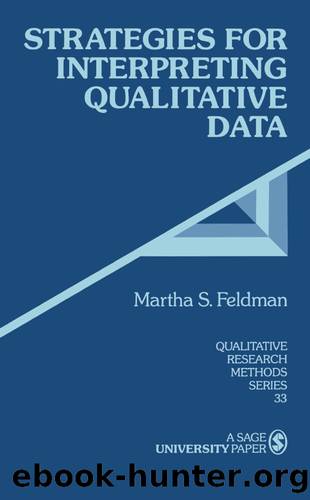Strategies for Interpreting Qualitative Data by Martha S. Feldman

Author:Martha S. Feldman [Feldman, Martha S.]
Language: eng
Format: epub
Tags: Social Science, Research
ISBN: 9780803959163
Google: EY6qy4UfVm8C
Publisher: SAGE
Published: 1995-01-15T03:35:18+00:00
Figure 3.4. The Home-Institution Relationship
We can use a semiotic square to explore further the home-institution relation discussed in the second semiotic analysis. Home is the prescription; institution is the prohibition. The square (Figure 3.4) helps us to see that, in this system of rules or meaning, âhomeâ implies ânot institutionâ and âinstitutionâ implies ânot home.â The more one emphasizes home, the more one deemphasizes institution. Thus any action within this system of rules has a double meaning; if it promotes home, it demotes institution and vice versa.
Another way the squares can be used is to map systems of rules in different domains. Greimas (1987, pp. 52-56) does this by mapping sexual relations in the cultural, economic, and personal spheres. In my research, different domains may be different parts of an organizationâunits or hierarchical levels, for instance. To illustrate this use of semiotic squares, I need first to describe briefly another routine in Housing. It is called the reserves process. It is a budgeting routine that allocates about 10% of the budget to specific projects within each residence hall.7 Over the years, I have observed the routine of the Residence Education and Facilities directors trying to get the managers at the building level to submit to them a list of projects the building-level managers all agree on for their buildings. Over the four years I observed the routine, the administrators tried several different means of obtaining these lists, which they refer to as consensus lists. They exhorted people, they changed forms, they asked for inclusive project lists rather than just lists of projects that could be funded within the available budget. These efforts produced little change. For the most part, buildings that had submitted consensus lists in the past continued to do so and buildings that hadnât didnât. Changes in personnel seemed to have the largest effects in either direction. Sometimes people in Residence Education would report that they had a consensus list in their building but, when the actual budget meetings took place, there would be two lists from that building. As I observed this process, I found it very puzzling that such a little change with so much high-level support could not be brought about.
Of course, one possibility is that it isnât a little change at all and that producing a consensus list would, in fact, cause dramatic changes in the interactions and power dynamics at the building level. While this is possible, the fact that some buildings did submit consensus lists suggests that there is nothing intrinsic in the roles of the managers that would impede such coordination.
I started to explore this question by mapping out a semiotic square that describes the prescription the central administrators support vis-Ã -vis their subordinatesâ positions in the reserves process (see Figure 3.5). What they are asking people to do is to focus on their building affiliation rather than their organizational affiliation. Thus the phrase buildingwide consensus is in the upper-left corner as the prescription and the phrase organizational affiliation is in the upper-right corner as the prohibition.
Download
This site does not store any files on its server. We only index and link to content provided by other sites. Please contact the content providers to delete copyright contents if any and email us, we'll remove relevant links or contents immediately.
Cecilia; Or, Memoirs of an Heiress — Volume 1 by Fanny Burney(32503)
Cecilia; Or, Memoirs of an Heiress — Volume 2 by Fanny Burney(31913)
Cecilia; Or, Memoirs of an Heiress — Volume 3 by Fanny Burney(31898)
The Great Music City by Andrea Baker(31759)
We're Going to Need More Wine by Gabrielle Union(19004)
All the Missing Girls by Megan Miranda(15787)
Pimp by Iceberg Slim(14438)
Bombshells: Glamour Girls of a Lifetime by Sullivan Steve(14024)
For the Love of Europe by Rick Steves(13630)
Talking to Strangers by Malcolm Gladwell(13298)
Norse Mythology by Gaiman Neil(13281)
Fifty Shades Freed by E L James(13189)
Mindhunter: Inside the FBI's Elite Serial Crime Unit by John E. Douglas & Mark Olshaker(9266)
Crazy Rich Asians by Kevin Kwan(9224)
The Lost Art of Listening by Michael P. Nichols(7456)
Enlightenment Now: The Case for Reason, Science, Humanism, and Progress by Steven Pinker(7274)
The Four Agreements by Don Miguel Ruiz(6704)
Bad Blood by John Carreyrou(6584)
Weapons of Math Destruction by Cathy O'Neil(6220)
